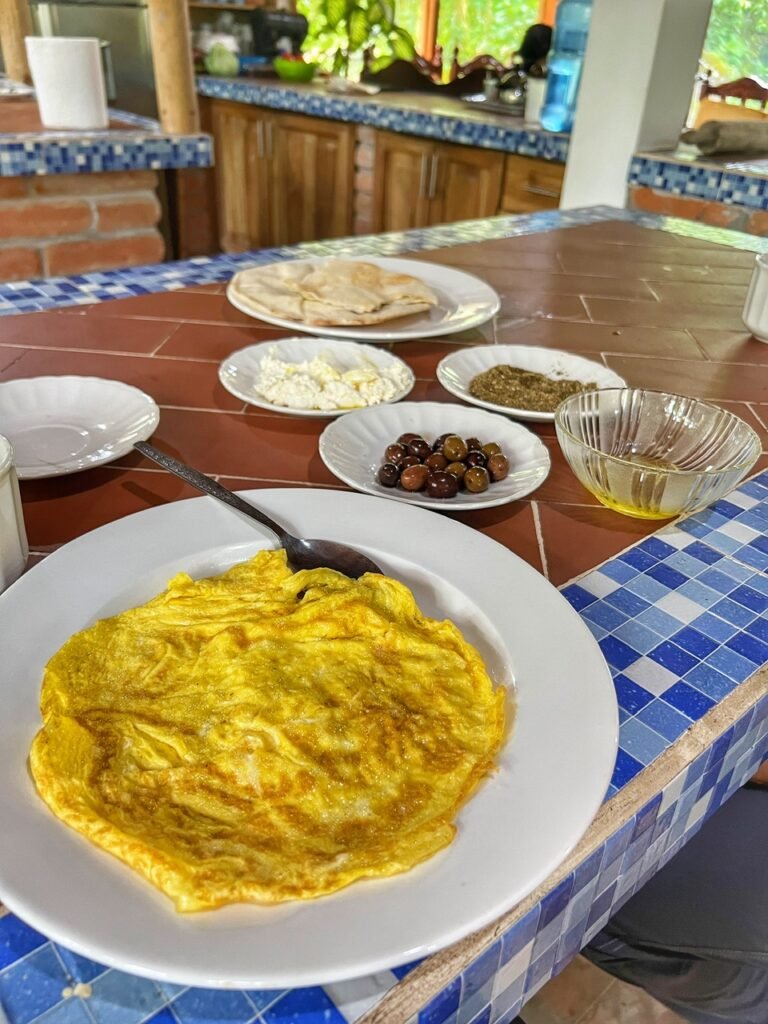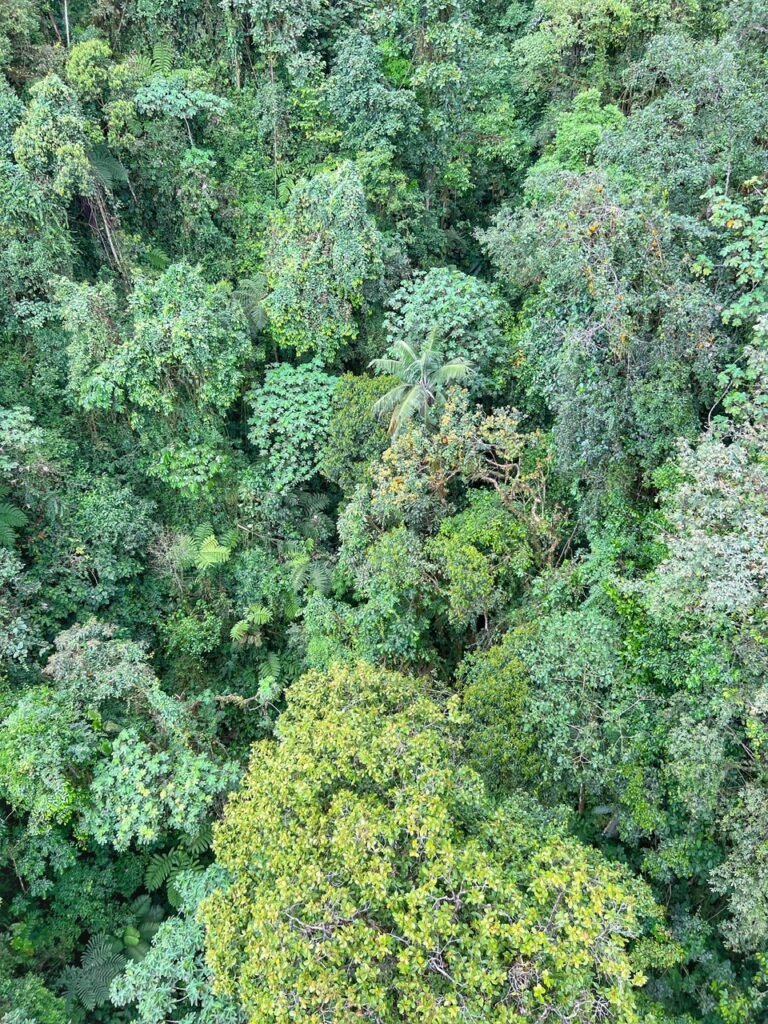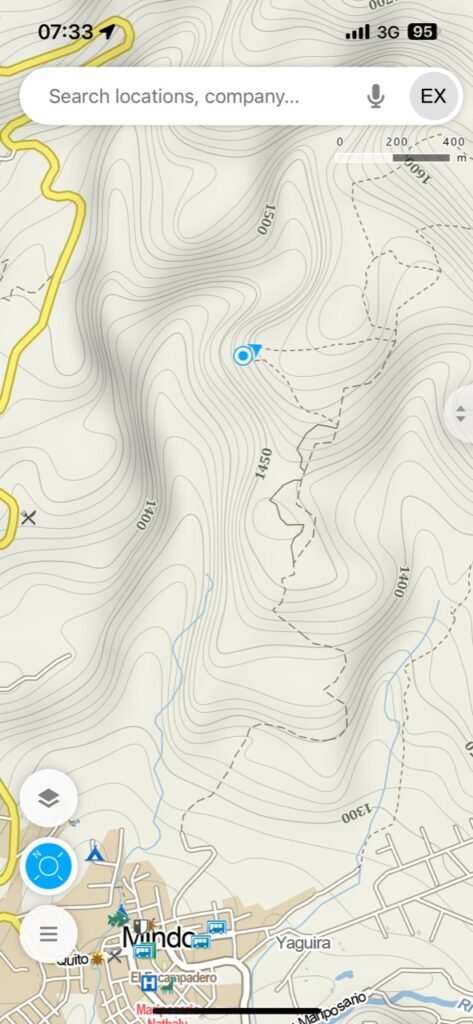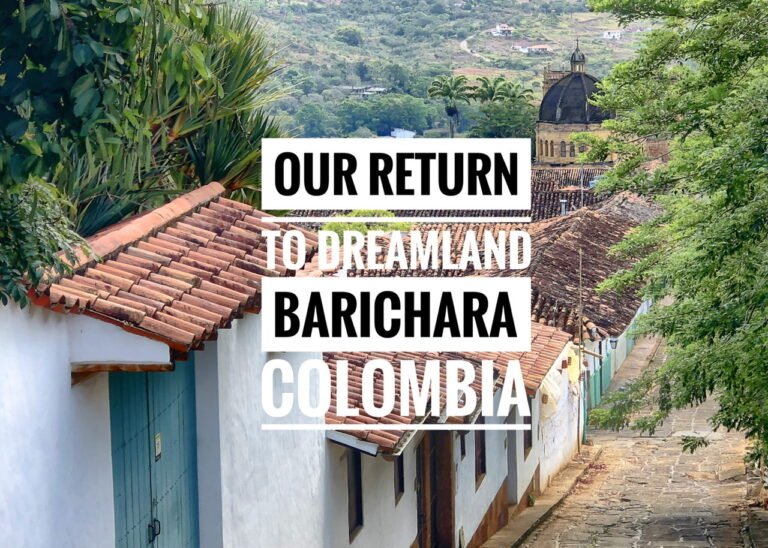
Folded within the lush Ecuadorian cloud forest, and only two hours by bus from Quito, one can find the sparkling jewel of Mindo Valley. It is known for being replete with natural beauty, chocolate tours, adventure activities and enough wild and bird life to fill its own Audubon book.
Where we Stayed
We arrived for two nights and chose Hostelería Lotus, tucked into the forest, along the River Mindo to stay, which was about a thirty minute easy walk outside of the village.
The place was run by a welcoming Syrian couple who had been living in Ecuador for the last seven years and couldn’t have made us feel more at home, with a delicious welcome dessert made from hibiscus, maté and shisha pipe nightcap and a Syrian breakfast which was a gladly received pause from Ecuadorian food.

The balcony overlooking the forest. Within a few minutes of arriving, we had already spotted more hummingbirds than we could count! One of them even had a little flitting tail!


One of the cabins overlooking the river of lushness. They were over budget for us at $70/night but did look enticing.

Our room was $21/night found on Booking.com and included a private bathroom and the complimentary lullaby of the river to sleep to.


Our balcony. And extra balcony bonus? A few adorable disposals on which to drop those kitty treats we had been carrying around.


In the evening, we joined Asim and his wife for a maté tea. We were very intrigued to learn that maté tea, which is very popular in Southern South America is also drunk regularly in Syria. It was our first maté tea on this trip and is something we look forward to more of. We also learned two important things: 1. Don’t swirl your bombilla (straw) around. 2) when you are finished, place your bombilla straight up in the glass. Until you do this, hot water will continuously be poured.
And of course, we couldn’t turn down the opportunity for a little shisha water pipe either. It was a great opportunity to learn their story and be reminded of how much we love the Middle Eastern culture.

And now that night was here, so were the critters. Check out the pincers on this guy! Not to mention the fact he was about three inches long.😲

Our delicious Syrian breakfast featured Turkish coffee, eggs, olives, bread and olive oils and labneh, a popular thick yogurt in the Middle East made of milk and salt.


The next morning we got a tour of the land including a luscious-looking greenhouse, which made our mouths water, as well as some of the tails, and trails, on the property.

The cozy-looking river cabin.


The River Mindo. Every once in awhile we would hear the tubers slide by our window with a squeal or two.
Exploring Mindo

In the rainforest, rain comes hand in hand, which usually tumbled from the sky at around 2 pm until the following morning. We figured out this rain schedule very quickly on our first day when trying to hike out to the seven waterfalls and quickly abandoned that plan. But we still managed to ride the cable car up the mountain, hike back down to the village and grab the most delicious arepas of our lives. Nothing like yellow wild orchids, this one called “Wydler’s Dancing Lady Orchid” native to the West Indies.

Crossing the Mindo River, which is very popular for tubing adventures.



Climbing aboard the Mindo Park Teleférico, which was $5 each. Or, one also has the option to pay $8 if you want the round-trip. There is a second teleférico costing another $5 if you want to go to the waterfalls. Since those costs were adding up quickly, our original plan had been to hike. Regardless, the teleférico itself was actually worth the $10. It was easily the most vertigo-inducing cable car we’d been on as you gazed at the 500 foot plummet down into the cloud forest. Mandy’s bigger fear of course, was dropping Big Gene (our phone.) FYI, he received his name when we got our little burner phone named Genita which is what we take out in public in lesser safe areas.

Like a floating canopy walk.

Excited to see our first creepy crawlie! This millipede, which for the record don’t have a thousand feet, looks dangerous because of its color, but we weren’t able to identify it.

If a banana were made for a princess, this would be it. Musa velutina, the hairy banana or pink banana, is a species of seeded banana. Its fruits are 3 in (8 cm) long, pink, and fuzzy. By the way, we’re testing out a new app called “Seek” to help us identify new things!


The stem of this guy looks either soft and strokeable or malicious and mean. The Philodendron is native to Costa Rica, Panama, Colombia, Ecuador and Peru, and is a hemiepiphyte climbing plant. It also looks a bit like one of those brushes used to clean beer bottles….🤔

One of the few bird pictures we managed to get. We’ll call him the black and yellow wobbler.


This showy shrub called the Brazilian Red Cloak blankets Mindo Valley and is native to Venezuela, Colombia, Brazil and Ecuador while the orange “Jamaican forget-me-not” is translated as “Pensamientos de Pobre” or “Thoughts of the Poor” in Spanish.


If you wanna sleep in a treehouse, the Eden Treehouse looks enticing. This is also where our night walk left from. Based on Booking, it costs about $55 a night including breakfast.

The crooked winding trees create a magical forest fit for a gnome.


And some of the most remarkable, giant bamboo we’ve ever seen. There are evidently more than 40 native species of bamboo throughout the country. The next cluster is plopped next to one of the many zip lining bridges.

To us, these canopy bridges are always the best part of zip lining.

Traversing the Mindo River once again….this time in the rain.

The token town sign.


We have yet to see a truly adorable village in Ecuador. They definitely don’t make them here like in Colombia. The church was a bit unique, however!

And since we had been in Ecuador for nearly seven weeks and hardly cracked into their most basic food group, we then decided to grab dinner at the 5-star clad arepa and empanada cantina called “My Little Venezia.”


Mandy had two bean and cheese empanadas for $1.75/each. Our diets had officially gone to crap in the 24 hours since we left the safety of our Quito kitchen. And Greg had the most delicious arepa we’ve ever had called “Reina Pepiada,” which was stuffed with spiced shredded chicken and a mix of guacamole and cheese. ($3.50) It was so good we returned the next day…something we rarely do!

During round two, we officially met the arepa master, Yosani, who in fact was from Venezuela (home of the arepa) but had Colombian and Venezuelan parents.


A bit less enticing, but even cheaper, Menu del Dia which consisted of vegetable soup, fried trout, rice, lentils, tomato salad, plantains and juice for $3/each.
Trying to be Birders

We are 100% amateur (and binocular-less) bird people, yet we knew that the best budget option for us in Mindo would be to try our own hand at spotting them. Therefore, after a 30-minute walk from our place, we arrived to Hacienda San Vincente, also called Yellow House, at 6 am. It features a private $6 trail supposedly housing 360 bird species, including 39 hummingbird types, and monkeys. And while we certainly heard a lot of birds, including the infamous crick-crick-crick of the toucan, we didn’t see a lot of winged critters, (other than a cool orange bug.) 🤣
However, that “crushed” expectation aside, the trails were amazing, still filled with flora, tranquility and wonder, and well worth it just for the hiking and cloud forest element alone. To go, you arrive to the Yellow House anytime after 6:15 am, pay your $6 (each) and a friendly man provide you with a map marked with areas you’re likely to see toucans and monkeys. Such a tease! (Or maybe our amateur eyes just failed us.) Regardless, walking on these trails was like strolling into a (liberated) aviary early in the morning. The sounds were simply enthralling.

More crooked gnarled árboles, called paper trees.

One of the few birds we actually got a photo of. Haha. We know. Embarrassing 🤣

Our app couldn’t pick it up, but this little pink beauty is definitely a type of orchid.

The sun starting to emerge! See, we told you the sun indeed shines in Mindo! 😉


Arriving to the mirador, where we were able to see the clouds still rolling through the mountains.


And it got even more beautiful as the sun started filtering through the trees.


Absolutely everywhere, the vines hung delicately like harp strings. Pero, donde están los pájaros?! 🐦

A Leaf Beetle. For the record, there were very few bothersome bugs at all on Mindo.

Paper trees showcasing epiphytes like ornaments over a green blanket begs for a picnic blanket.

And of course the trails were connected to Mapy. We spent a total of three hours wandering the trails and had over 30,000 steps that day. It pays to get moving at 6! 😁


(1) The Brazilian Plume Flower or King’s Crown is native to Ecuador. (All identified with the app, Leaf Snap). (2) The Torch Ginger, native to Southeast Asia, where its flowers are an essential ingredient in many Malay, Indonesian and Thai dishes. Funny, we still don’t look at it and think, damn that’s a delicious looking flower!


(1) It’s easy to see where this artistic little treasure called the Golden Shrimp plant got its name. (2) The also superbly named Chinese Lantern flower.
Mindo Night Walk



Although the nights in Mindo are often dark and damp, it pays to get outside because the area is rich with discovery. There are two main activities most people do: attend a “live” frog concert at Mindo Lake ($5/person) or go on a night walk. We decided to splurge on the night walk, which was $15/person with Mindo Night Walks and can be registered for at any agency in town. It was a unique experience, filled with new jungle sounds and senses, but for us, probably not worth the extra cost because we (again 🤣) didn’t see too much even with the help of a guide and the tour group size just felt a bit too big.
The thumb nail sized Ecuadorian glass frog. You wouldn’t believe how much noise this little guy can belt out. It was fun to watch the guide call for him and proceed to fish him out of a small pond. Because they are semi-transparent, glass frogs are also famously good at camouflage, blending into the undersides of leaves. You will very rarely see one during the day time.

We never saw an awake one, but we did see a feathery green plume of a sleeping toucan!

A black millipede crawling on a bristly stem plant.

The night walk definitely wouldn’t be recommended for anyone who is mobility challenged. Although they gave you a flashlight, in addition to navigating the dark we had to maneuver a very awkward rope bridge!

This Maleficent-resembling spider, which we’ve seen in Colombia, is a harmless whip scorpion, but despite its name and appearance, it’s neither a scorpion nor a spider. These strange creatures belong to a separate arachnid order called Amblypygi, meaning “blunt rump,” a reference to their lack of tails.

A giant cockroach (about 4 inches) with a very blue booty.



The more interesting part came at the end of the tour when the guide announced that his agency had just rescued a not-so-welcome highly venomous Fer-de-Lance viper from a nearby hotel pool. Unfortunately this happens every couple months in Mindo and Eric, a Canadian who has bravely relocated to help local wildlife, is the one who is called. The plan was to relocate the snake far away from people in the cloud forest the next day. The types of snakes are normally not aggressive with people unless provoked.



